Pearson BTEC Higher National: ESBM Assignment on Entrepreneurship
VerifiedAdded on 2022/12/29
|12
|2681
|96
Report
AI Summary
This report provides a comprehensive analysis of entrepreneurship and small business management, covering various aspects such as different types of entrepreneurial ventures, their relation to the typology of entrepreneurship, and the similarities and differences between them. It examines the impact of micro and small businesses on the economy, with specific data and statistics. The report also explores the importance of small businesses and business start-ups to the growth of the social economy, and evaluates the differences small, medium, and large businesses make to the economy. The study also critically examines the impact of small businesses on local, regional, national, and international levels, offering a detailed overview of their contributions and effects. The report uses data and statistics to support its claims, providing a thorough understanding of the subject matter.

ASSIGNMENT SUBMISSION FORM
This sheet must be submitted with your assignment.
Failure to complete, sign and submit this form will result in a mark of ‘0’ for the
assignment.
Student Name
Student ID
Assessor Name
Group No
Qualification Pearson BTEC Higher National in Business(Management)
Unit Number & Unit Title Unit 9 - Entrepreneurship and Small Business Management
Assignment Title Entrepreneurship and Small Business Management
Date of Submission
Signature: ……………………………………… Date: ………………………………
1
This sheet must be submitted with your assignment.
Failure to complete, sign and submit this form will result in a mark of ‘0’ for the
assignment.
Student Name
Student ID
Assessor Name
Group No
Qualification Pearson BTEC Higher National in Business(Management)
Unit Number & Unit Title Unit 9 - Entrepreneurship and Small Business Management
Assignment Title Entrepreneurship and Small Business Management
Date of Submission
Signature: ……………………………………… Date: ………………………………
1
Paraphrase This Document
Need a fresh take? Get an instant paraphrase of this document with our AI Paraphraser

ESBM
Introduction
(Briefly state the purpose of this unit and the knowledge expected to gain in completing the
unit.)
The aim for this assignment is to assist anyone trying to understand this subject to gaining the
knowledge and skills desired in the field of entrepreneurship and small business management.
2
Introduction
(Briefly state the purpose of this unit and the knowledge expected to gain in completing the
unit.)
The aim for this assignment is to assist anyone trying to understand this subject to gaining the
knowledge and skills desired in the field of entrepreneurship and small business management.
2
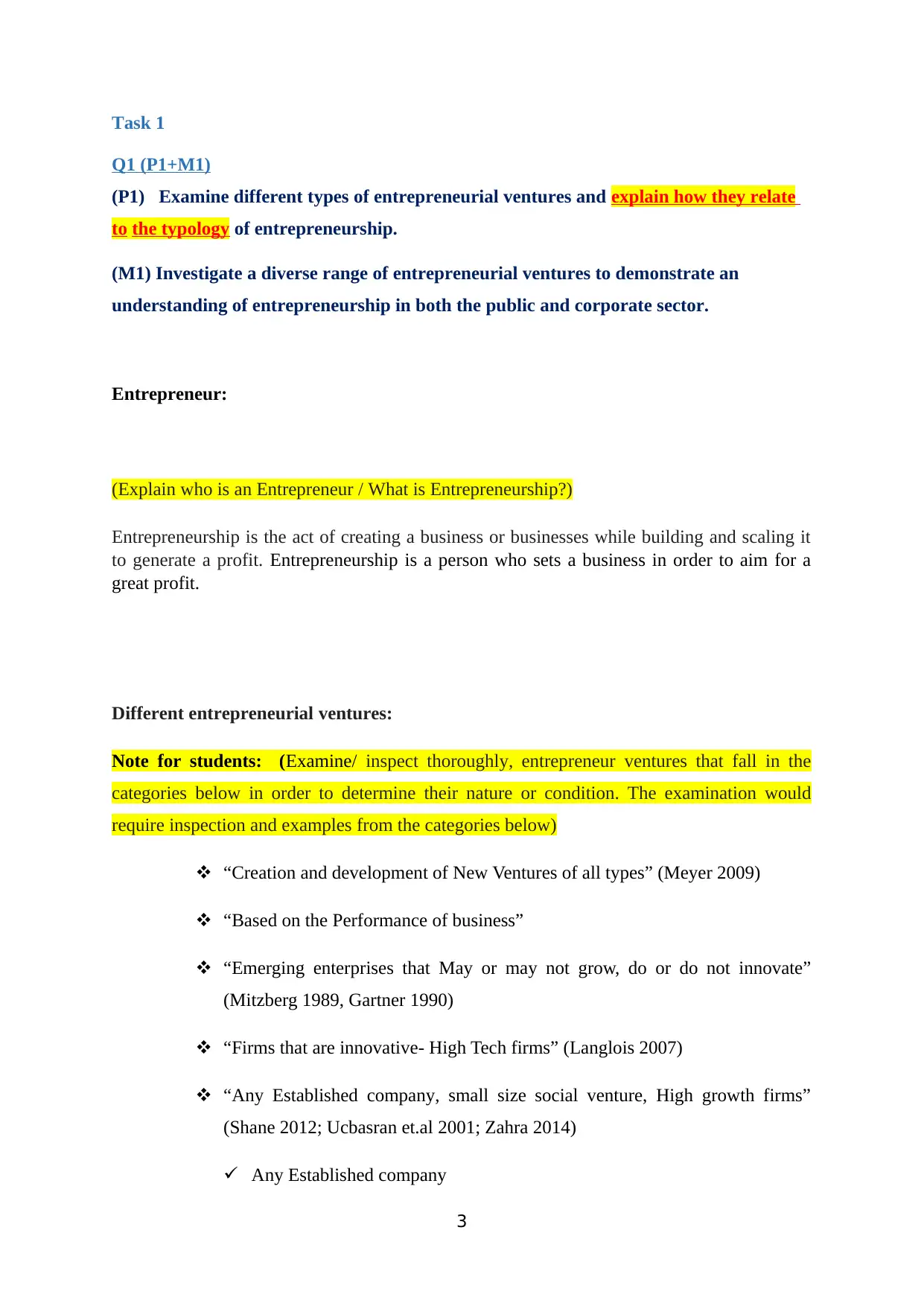
Task 1
Q1 (P1+M1)
(P1) Examine different types of entrepreneurial ventures and explain how they relate
to the typology of entrepreneurship.
(M1) Investigate a diverse range of entrepreneurial ventures to demonstrate an
understanding of entrepreneurship in both the public and corporate sector.
Entrepreneur:
(Explain who is an Entrepreneur / What is Entrepreneurship?)
Entrepreneurship is the act of creating a business or businesses while building and scaling it
to generate a profit. Entrepreneurship is a person who sets a business in order to aim for a
great profit.
Different entrepreneurial ventures:
Note for students: (Examine/ inspect thoroughly, entrepreneur ventures that fall in the
categories below in order to determine their nature or condition. The examination would
require inspection and examples from the categories below)
“Creation and development of New Ventures of all types” (Meyer 2009)
“Based on the Performance of business”
“Emerging enterprises that May or may not grow, do or do not innovate”
(Mitzberg 1989, Gartner 1990)
“Firms that are innovative- High Tech firms” (Langlois 2007)
“Any Established company, small size social venture, High growth firms”
(Shane 2012; Ucbasran et.al 2001; Zahra 2014)
Any Established company
3
Q1 (P1+M1)
(P1) Examine different types of entrepreneurial ventures and explain how they relate
to the typology of entrepreneurship.
(M1) Investigate a diverse range of entrepreneurial ventures to demonstrate an
understanding of entrepreneurship in both the public and corporate sector.
Entrepreneur:
(Explain who is an Entrepreneur / What is Entrepreneurship?)
Entrepreneurship is the act of creating a business or businesses while building and scaling it
to generate a profit. Entrepreneurship is a person who sets a business in order to aim for a
great profit.
Different entrepreneurial ventures:
Note for students: (Examine/ inspect thoroughly, entrepreneur ventures that fall in the
categories below in order to determine their nature or condition. The examination would
require inspection and examples from the categories below)
“Creation and development of New Ventures of all types” (Meyer 2009)
“Based on the Performance of business”
“Emerging enterprises that May or may not grow, do or do not innovate”
(Mitzberg 1989, Gartner 1990)
“Firms that are innovative- High Tech firms” (Langlois 2007)
“Any Established company, small size social venture, High growth firms”
(Shane 2012; Ucbasran et.al 2001; Zahra 2014)
Any Established company
3
⊘ This is a preview!⊘
Do you want full access?
Subscribe today to unlock all pages.

Trusted by 1+ million students worldwide

Small size social venture
Large size social venture
High growth firms
4
Large size social venture
High growth firms
4
Paraphrase This Document
Need a fresh take? Get an instant paraphrase of this document with our AI Paraphraser
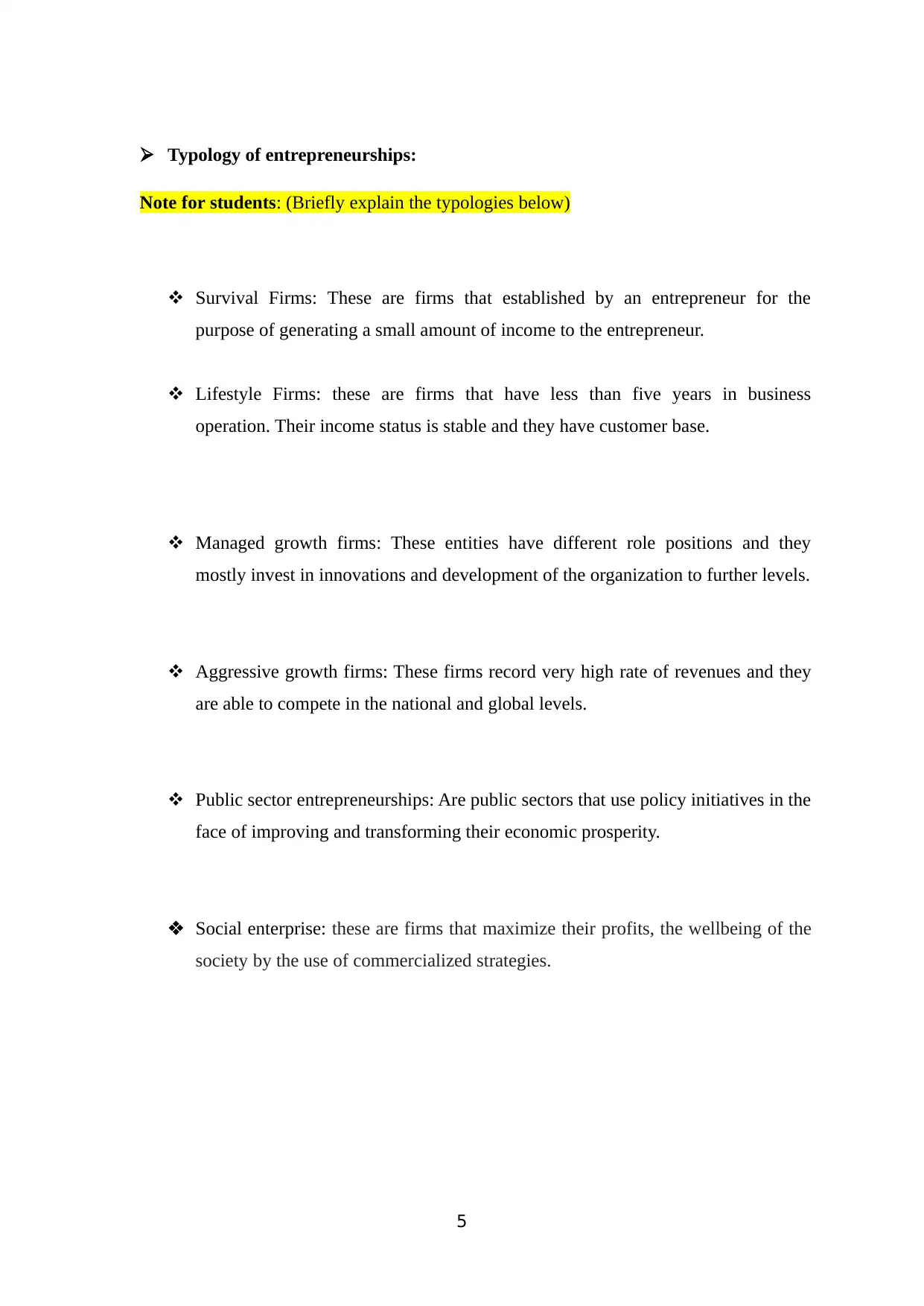
Typology of entrepreneurships:
Note for students: (Briefly explain the typologies below)
Survival Firms: These are firms that established by an entrepreneur for the
purpose of generating a small amount of income to the entrepreneur.
Lifestyle Firms: these are firms that have less than five years in business
operation. Their income status is stable and they have customer base.
Managed growth firms: These entities have different role positions and they
mostly invest in innovations and development of the organization to further levels.
Aggressive growth firms: These firms record very high rate of revenues and they
are able to compete in the national and global levels.
Public sector entrepreneurships: Are public sectors that use policy initiatives in the
face of improving and transforming their economic prosperity.
Social enterprise: these are firms that maximize their profits, the wellbeing of the
society by the use of commercialized strategies.
5
Note for students: (Briefly explain the typologies below)
Survival Firms: These are firms that established by an entrepreneur for the
purpose of generating a small amount of income to the entrepreneur.
Lifestyle Firms: these are firms that have less than five years in business
operation. Their income status is stable and they have customer base.
Managed growth firms: These entities have different role positions and they
mostly invest in innovations and development of the organization to further levels.
Aggressive growth firms: These firms record very high rate of revenues and they
are able to compete in the national and global levels.
Public sector entrepreneurships: Are public sectors that use policy initiatives in the
face of improving and transforming their economic prosperity.
Social enterprise: these are firms that maximize their profits, the wellbeing of the
society by the use of commercialized strategies.
5
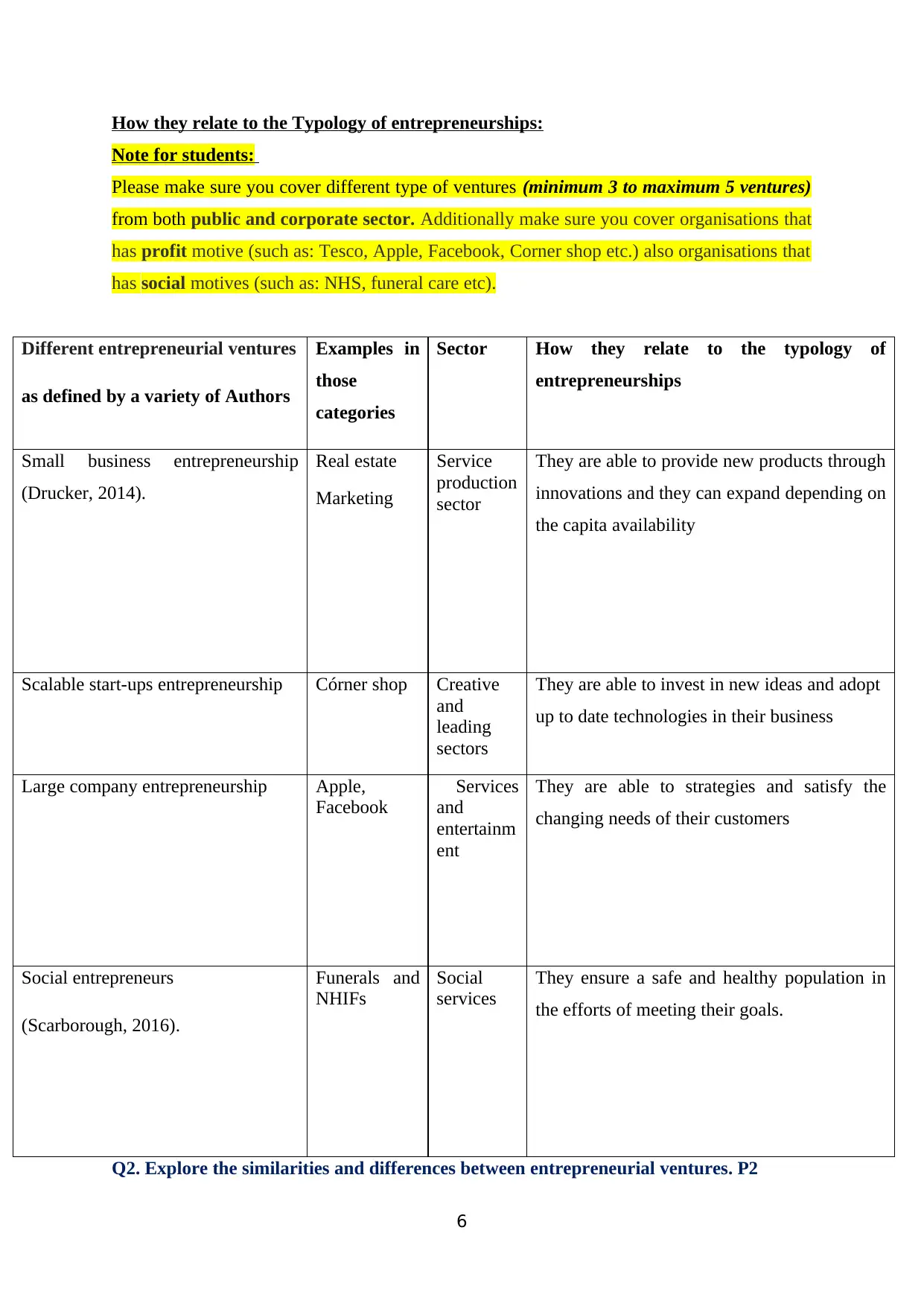
How they relate to the Typology of entrepreneurships:
Note for students:
Please make sure you cover different type of ventures (minimum 3 to maximum 5 ventures)
from both public and corporate sector. Additionally make sure you cover organisations that
has profit motive (such as: Tesco, Apple, Facebook, Corner shop etc.) also organisations that
has social motives (such as: NHS, funeral care etc).
Different entrepreneurial ventures
as defined by a variety of Authors
Examples in
those
categories
Sector How they relate to the typology of
entrepreneurships
Small business entrepreneurship
(Drucker, 2014).
Real estate
Marketing
Service
production
sector
They are able to provide new products through
innovations and they can expand depending on
the capita availability
Scalable start-ups entrepreneurship Córner shop Creative
and
leading
sectors
They are able to invest in new ideas and adopt
up to date technologies in their business
Large company entrepreneurship Apple,
Facebook
Services
and
entertainm
ent
They are able to strategies and satisfy the
changing needs of their customers
Social entrepreneurs
(Scarborough, 2016).
Funerals and
NHIFs
Social
services
They ensure a safe and healthy population in
the efforts of meeting their goals.
Q2. Explore the similarities and differences between entrepreneurial ventures. P2
6
Note for students:
Please make sure you cover different type of ventures (minimum 3 to maximum 5 ventures)
from both public and corporate sector. Additionally make sure you cover organisations that
has profit motive (such as: Tesco, Apple, Facebook, Corner shop etc.) also organisations that
has social motives (such as: NHS, funeral care etc).
Different entrepreneurial ventures
as defined by a variety of Authors
Examples in
those
categories
Sector How they relate to the typology of
entrepreneurships
Small business entrepreneurship
(Drucker, 2014).
Real estate
Marketing
Service
production
sector
They are able to provide new products through
innovations and they can expand depending on
the capita availability
Scalable start-ups entrepreneurship Córner shop Creative
and
leading
sectors
They are able to invest in new ideas and adopt
up to date technologies in their business
Large company entrepreneurship Apple,
Services
and
entertainm
ent
They are able to strategies and satisfy the
changing needs of their customers
Social entrepreneurs
(Scarborough, 2016).
Funerals and
NHIFs
Social
services
They ensure a safe and healthy population in
the efforts of meeting their goals.
Q2. Explore the similarities and differences between entrepreneurial ventures. P2
6
⊘ This is a preview!⊘
Do you want full access?
Subscribe today to unlock all pages.

Trusted by 1+ million students worldwide
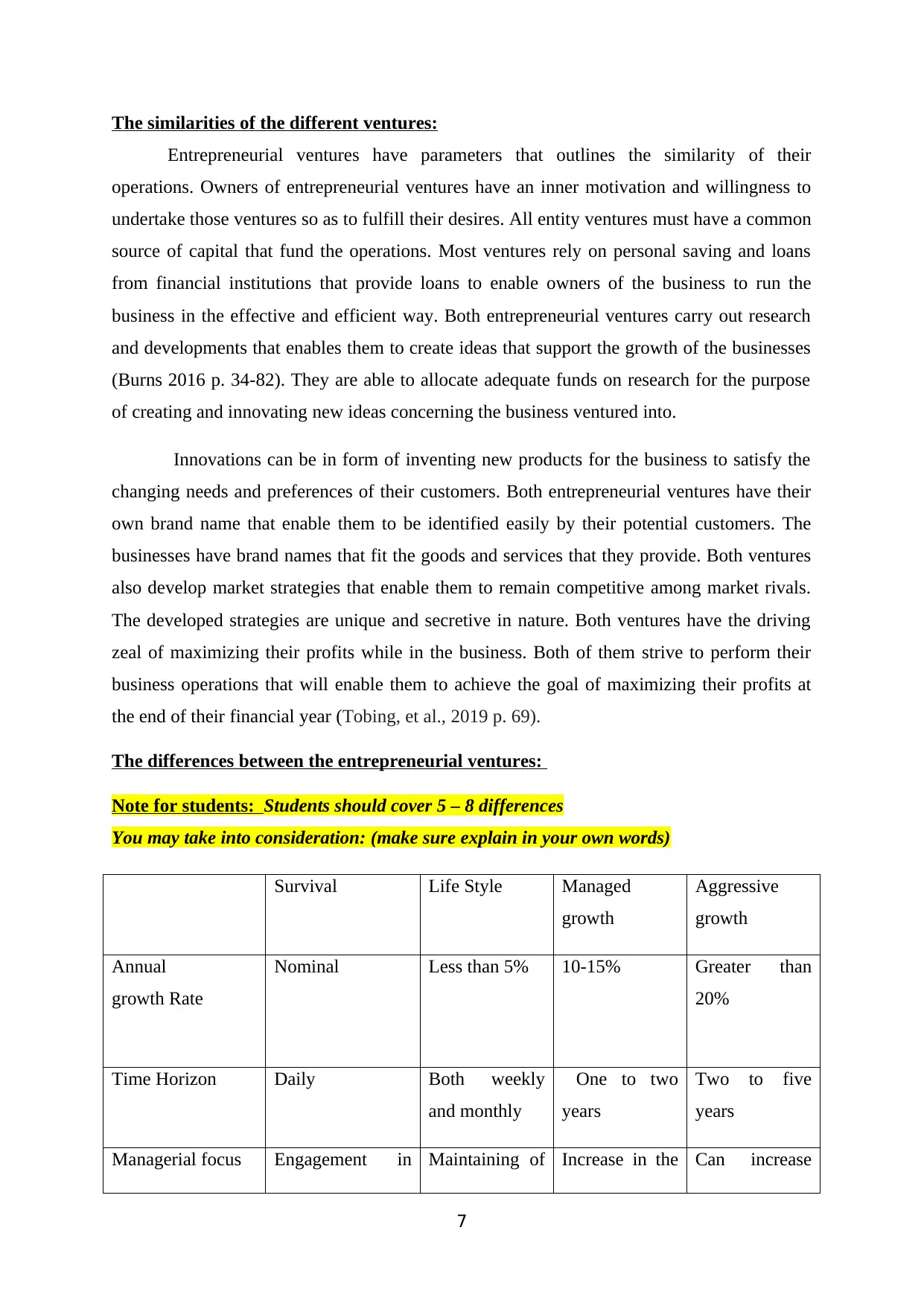
The similarities of the different ventures:
Entrepreneurial ventures have parameters that outlines the similarity of their
operations. Owners of entrepreneurial ventures have an inner motivation and willingness to
undertake those ventures so as to fulfill their desires. All entity ventures must have a common
source of capital that fund the operations. Most ventures rely on personal saving and loans
from financial institutions that provide loans to enable owners of the business to run the
business in the effective and efficient way. Both entrepreneurial ventures carry out research
and developments that enables them to create ideas that support the growth of the businesses
(Burns 2016 p. 34-82). They are able to allocate adequate funds on research for the purpose
of creating and innovating new ideas concerning the business ventured into.
Innovations can be in form of inventing new products for the business to satisfy the
changing needs and preferences of their customers. Both entrepreneurial ventures have their
own brand name that enable them to be identified easily by their potential customers. The
businesses have brand names that fit the goods and services that they provide. Both ventures
also develop market strategies that enable them to remain competitive among market rivals.
The developed strategies are unique and secretive in nature. Both ventures have the driving
zeal of maximizing their profits while in the business. Both of them strive to perform their
business operations that will enable them to achieve the goal of maximizing their profits at
the end of their financial year (Tobing, et al., 2019 p. 69).
The differences between the entrepreneurial ventures:
Note for students: Students should cover 5 – 8 differences
You may take into consideration: (make sure explain in your own words)
Survival Life Style Managed
growth
Aggressive
growth
Annual
growth Rate
Nominal Less than 5% 10-15% Greater than
20%
Time Horizon Daily Both weekly
and monthly
One to two
years
Two to five
years
Managerial focus Engagement in Maintaining of Increase in the Can increase
7
Entrepreneurial ventures have parameters that outlines the similarity of their
operations. Owners of entrepreneurial ventures have an inner motivation and willingness to
undertake those ventures so as to fulfill their desires. All entity ventures must have a common
source of capital that fund the operations. Most ventures rely on personal saving and loans
from financial institutions that provide loans to enable owners of the business to run the
business in the effective and efficient way. Both entrepreneurial ventures carry out research
and developments that enables them to create ideas that support the growth of the businesses
(Burns 2016 p. 34-82). They are able to allocate adequate funds on research for the purpose
of creating and innovating new ideas concerning the business ventured into.
Innovations can be in form of inventing new products for the business to satisfy the
changing needs and preferences of their customers. Both entrepreneurial ventures have their
own brand name that enable them to be identified easily by their potential customers. The
businesses have brand names that fit the goods and services that they provide. Both ventures
also develop market strategies that enable them to remain competitive among market rivals.
The developed strategies are unique and secretive in nature. Both ventures have the driving
zeal of maximizing their profits while in the business. Both of them strive to perform their
business operations that will enable them to achieve the goal of maximizing their profits at
the end of their financial year (Tobing, et al., 2019 p. 69).
The differences between the entrepreneurial ventures:
Note for students: Students should cover 5 – 8 differences
You may take into consideration: (make sure explain in your own words)
Survival Life Style Managed
growth
Aggressive
growth
Annual
growth Rate
Nominal Less than 5% 10-15% Greater than
20%
Time Horizon Daily Both weekly
and monthly
One to two
years
Two to five
years
Managerial focus Engagement in Maintaining of Increase in the Can increase
7
Paraphrase This Document
Need a fresh take? Get an instant paraphrase of this document with our AI Paraphraser
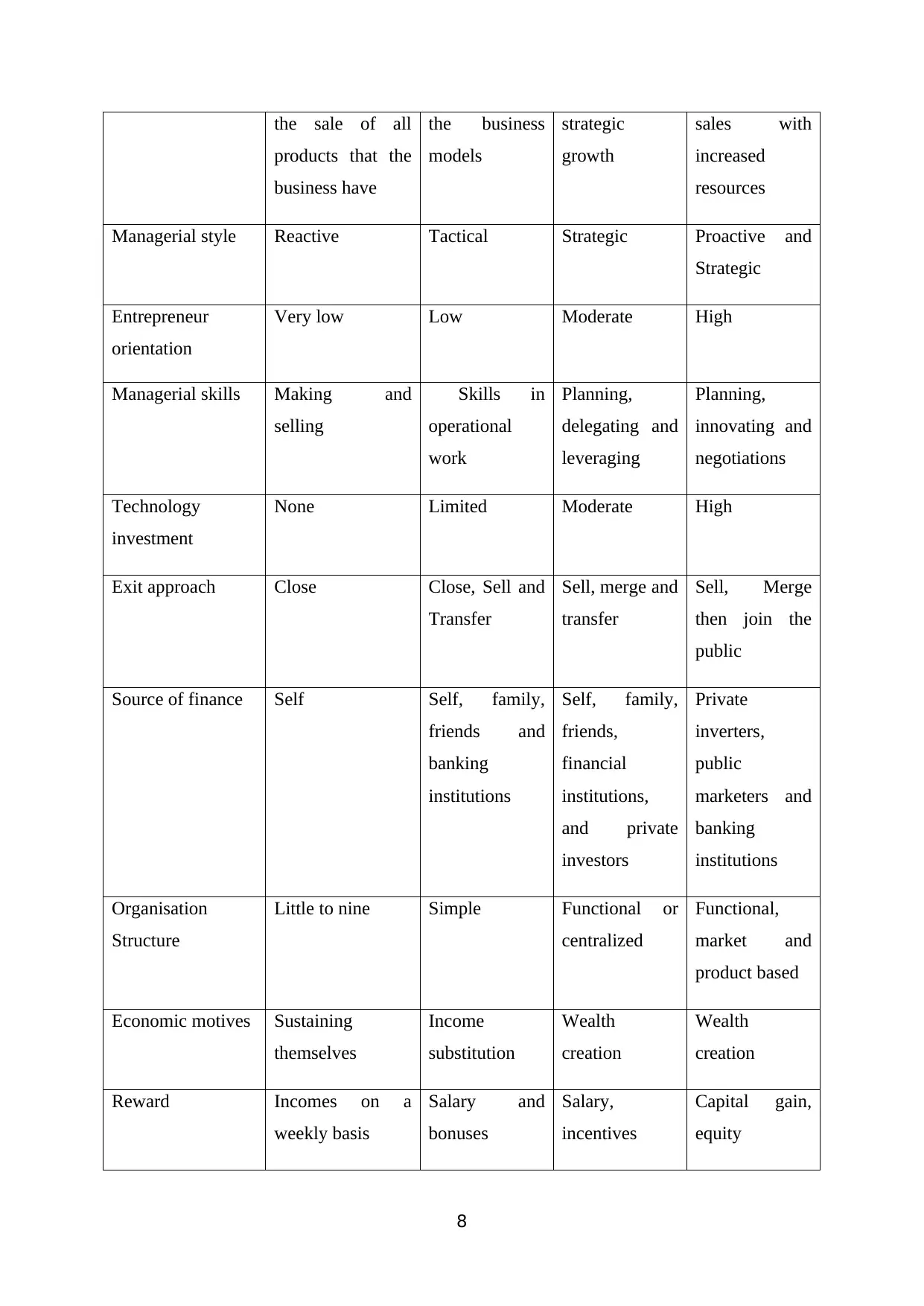
the sale of all
products that the
business have
the business
models
strategic
growth
sales with
increased
resources
Managerial style Reactive Tactical Strategic Proactive and
Strategic
Entrepreneur
orientation
Very low Low Moderate High
Managerial skills Making and
selling
Skills in
operational
work
Planning,
delegating and
leveraging
Planning,
innovating and
negotiations
Technology
investment
None Limited Moderate High
Exit approach Close Close, Sell and
Transfer
Sell, merge and
transfer
Sell, Merge
then join the
public
Source of finance Self Self, family,
friends and
banking
institutions
Self, family,
friends,
financial
institutions,
and private
investors
Private
inverters,
public
marketers and
banking
institutions
Organisation
Structure
Little to nine Simple Functional or
centralized
Functional,
market and
product based
Economic motives Sustaining
themselves
Income
substitution
Wealth
creation
Wealth
creation
Reward Incomes on a
weekly basis
Salary and
bonuses
Salary,
incentives
Capital gain,
equity
8
products that the
business have
the business
models
strategic
growth
sales with
increased
resources
Managerial style Reactive Tactical Strategic Proactive and
Strategic
Entrepreneur
orientation
Very low Low Moderate High
Managerial skills Making and
selling
Skills in
operational
work
Planning,
delegating and
leveraging
Planning,
innovating and
negotiations
Technology
investment
None Limited Moderate High
Exit approach Close Close, Sell and
Transfer
Sell, merge and
transfer
Sell, Merge
then join the
public
Source of finance Self Self, family,
friends and
banking
institutions
Self, family,
friends,
financial
institutions,
and private
investors
Private
inverters,
public
marketers and
banking
institutions
Organisation
Structure
Little to nine Simple Functional or
centralized
Functional,
market and
product based
Economic motives Sustaining
themselves
Income
substitution
Wealth
creation
Wealth
creation
Reward Incomes on a
weekly basis
Salary and
bonuses
Salary,
incentives
Capital gain,
equity
8
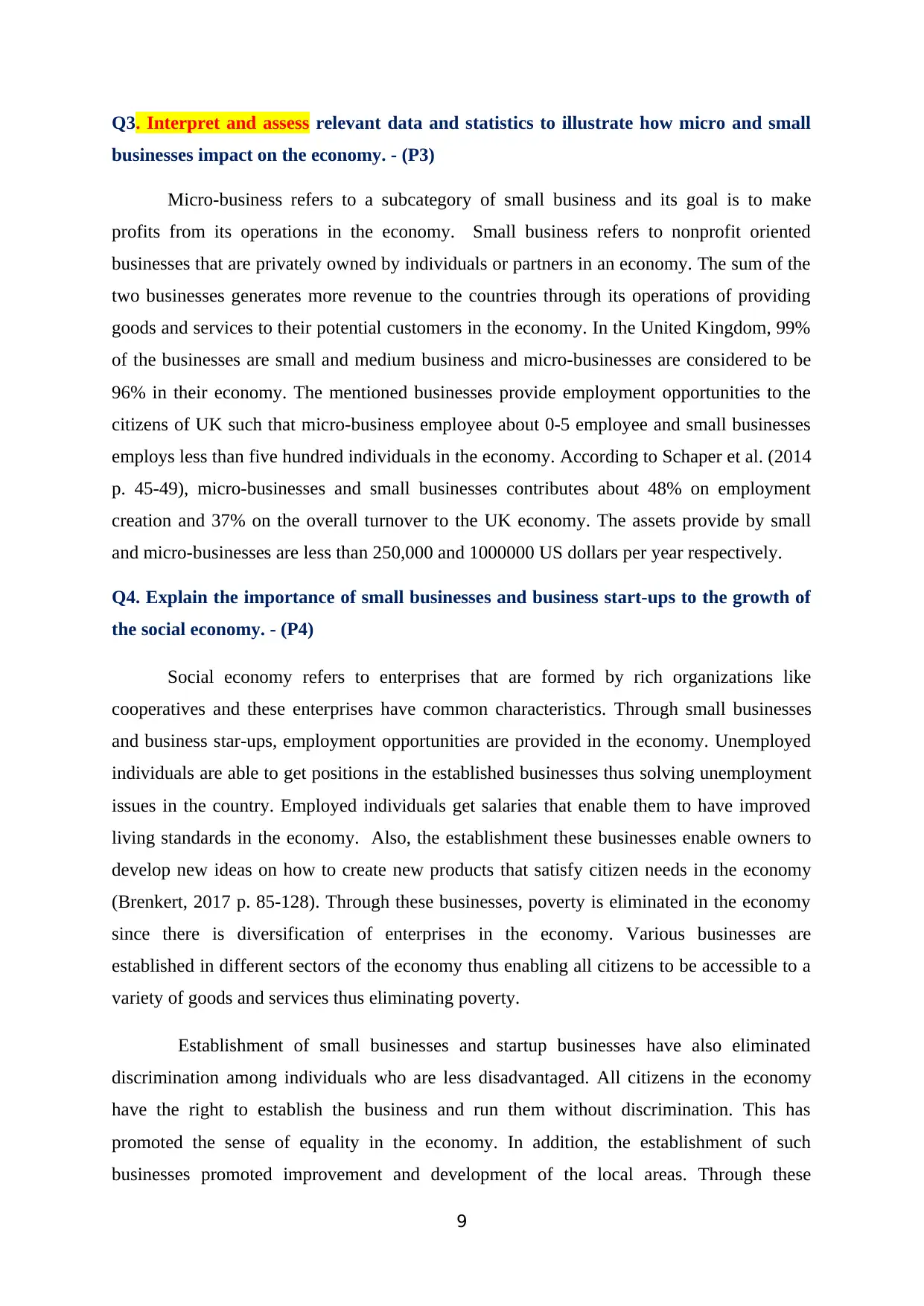
Q3. Interpret and assess relevant data and statistics to illustrate how micro and small
businesses impact on the economy. - (P3)
Micro-business refers to a subcategory of small business and its goal is to make
profits from its operations in the economy. Small business refers to nonprofit oriented
businesses that are privately owned by individuals or partners in an economy. The sum of the
two businesses generates more revenue to the countries through its operations of providing
goods and services to their potential customers in the economy. In the United Kingdom, 99%
of the businesses are small and medium business and micro-businesses are considered to be
96% in their economy. The mentioned businesses provide employment opportunities to the
citizens of UK such that micro-business employee about 0-5 employee and small businesses
employs less than five hundred individuals in the economy. According to Schaper et al. (2014
p. 45-49), micro-businesses and small businesses contributes about 48% on employment
creation and 37% on the overall turnover to the UK economy. The assets provide by small
and micro-businesses are less than 250,000 and 1000000 US dollars per year respectively.
Q4. Explain the importance of small businesses and business start-ups to the growth of
the social economy. - (P4)
Social economy refers to enterprises that are formed by rich organizations like
cooperatives and these enterprises have common characteristics. Through small businesses
and business star-ups, employment opportunities are provided in the economy. Unemployed
individuals are able to get positions in the established businesses thus solving unemployment
issues in the country. Employed individuals get salaries that enable them to have improved
living standards in the economy. Also, the establishment these businesses enable owners to
develop new ideas on how to create new products that satisfy citizen needs in the economy
(Brenkert, 2017 p. 85-128). Through these businesses, poverty is eliminated in the economy
since there is diversification of enterprises in the economy. Various businesses are
established in different sectors of the economy thus enabling all citizens to be accessible to a
variety of goods and services thus eliminating poverty.
Establishment of small businesses and startup businesses have also eliminated
discrimination among individuals who are less disadvantaged. All citizens in the economy
have the right to establish the business and run them without discrimination. This has
promoted the sense of equality in the economy. In addition, the establishment of such
businesses promoted improvement and development of the local areas. Through these
9
businesses impact on the economy. - (P3)
Micro-business refers to a subcategory of small business and its goal is to make
profits from its operations in the economy. Small business refers to nonprofit oriented
businesses that are privately owned by individuals or partners in an economy. The sum of the
two businesses generates more revenue to the countries through its operations of providing
goods and services to their potential customers in the economy. In the United Kingdom, 99%
of the businesses are small and medium business and micro-businesses are considered to be
96% in their economy. The mentioned businesses provide employment opportunities to the
citizens of UK such that micro-business employee about 0-5 employee and small businesses
employs less than five hundred individuals in the economy. According to Schaper et al. (2014
p. 45-49), micro-businesses and small businesses contributes about 48% on employment
creation and 37% on the overall turnover to the UK economy. The assets provide by small
and micro-businesses are less than 250,000 and 1000000 US dollars per year respectively.
Q4. Explain the importance of small businesses and business start-ups to the growth of
the social economy. - (P4)
Social economy refers to enterprises that are formed by rich organizations like
cooperatives and these enterprises have common characteristics. Through small businesses
and business star-ups, employment opportunities are provided in the economy. Unemployed
individuals are able to get positions in the established businesses thus solving unemployment
issues in the country. Employed individuals get salaries that enable them to have improved
living standards in the economy. Also, the establishment these businesses enable owners to
develop new ideas on how to create new products that satisfy citizen needs in the economy
(Brenkert, 2017 p. 85-128). Through these businesses, poverty is eliminated in the economy
since there is diversification of enterprises in the economy. Various businesses are
established in different sectors of the economy thus enabling all citizens to be accessible to a
variety of goods and services thus eliminating poverty.
Establishment of small businesses and startup businesses have also eliminated
discrimination among individuals who are less disadvantaged. All citizens in the economy
have the right to establish the business and run them without discrimination. This has
promoted the sense of equality in the economy. In addition, the establishment of such
businesses promoted improvement and development of the local areas. Through these
9
⊘ This is a preview!⊘
Do you want full access?
Subscribe today to unlock all pages.

Trusted by 1+ million students worldwide
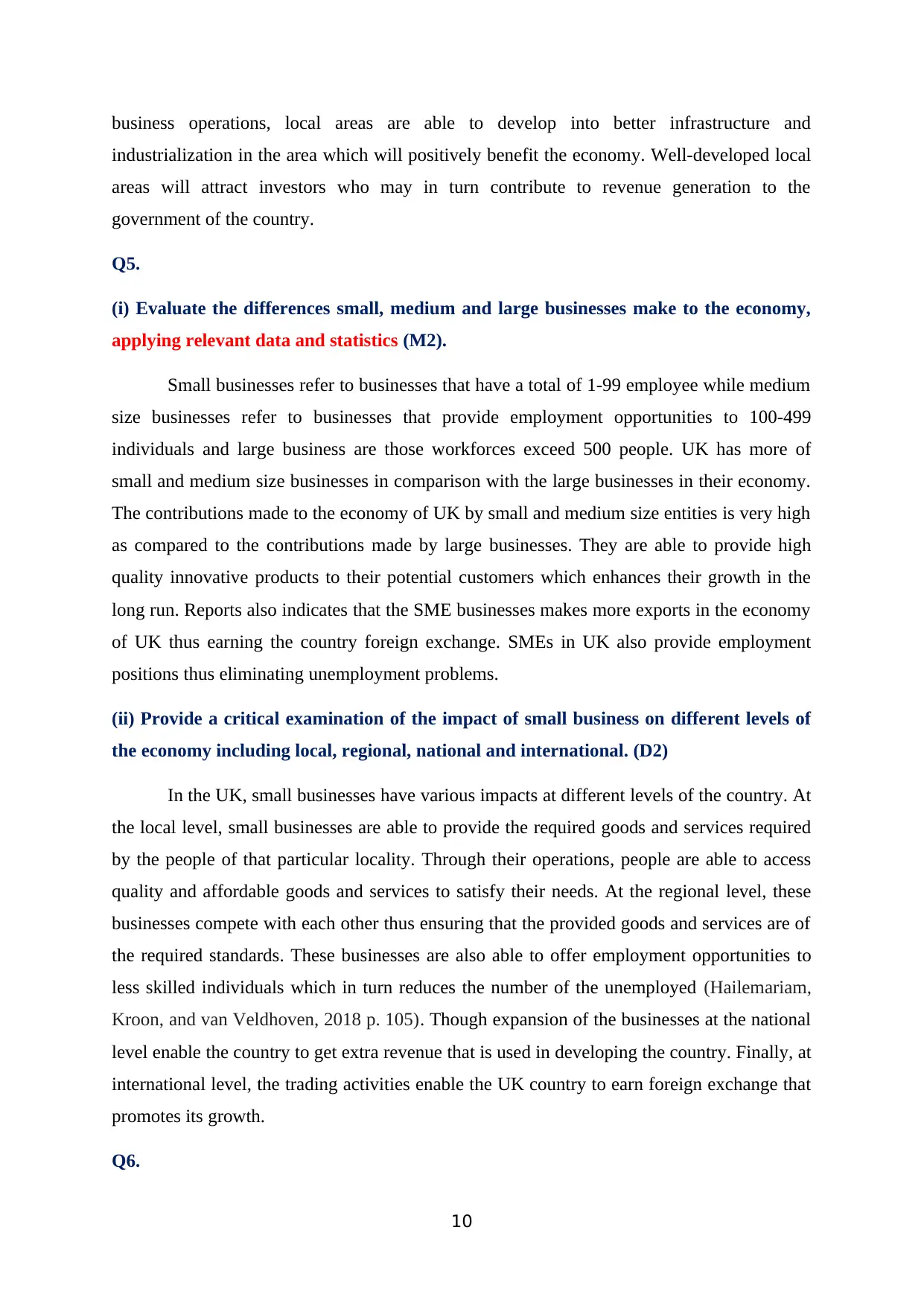
business operations, local areas are able to develop into better infrastructure and
industrialization in the area which will positively benefit the economy. Well-developed local
areas will attract investors who may in turn contribute to revenue generation to the
government of the country.
Q5.
(i) Evaluate the differences small, medium and large businesses make to the economy,
applying relevant data and statistics (M2).
Small businesses refer to businesses that have a total of 1-99 employee while medium
size businesses refer to businesses that provide employment opportunities to 100-499
individuals and large business are those workforces exceed 500 people. UK has more of
small and medium size businesses in comparison with the large businesses in their economy.
The contributions made to the economy of UK by small and medium size entities is very high
as compared to the contributions made by large businesses. They are able to provide high
quality innovative products to their potential customers which enhances their growth in the
long run. Reports also indicates that the SME businesses makes more exports in the economy
of UK thus earning the country foreign exchange. SMEs in UK also provide employment
positions thus eliminating unemployment problems.
(ii) Provide a critical examination of the impact of small business on different levels of
the economy including local, regional, national and international. (D2)
In the UK, small businesses have various impacts at different levels of the country. At
the local level, small businesses are able to provide the required goods and services required
by the people of that particular locality. Through their operations, people are able to access
quality and affordable goods and services to satisfy their needs. At the regional level, these
businesses compete with each other thus ensuring that the provided goods and services are of
the required standards. These businesses are also able to offer employment opportunities to
less skilled individuals which in turn reduces the number of the unemployed (Hailemariam,
Kroon, and van Veldhoven, 2018 p. 105). Though expansion of the businesses at the national
level enable the country to get extra revenue that is used in developing the country. Finally, at
international level, the trading activities enable the UK country to earn foreign exchange that
promotes its growth.
Q6.
10
industrialization in the area which will positively benefit the economy. Well-developed local
areas will attract investors who may in turn contribute to revenue generation to the
government of the country.
Q5.
(i) Evaluate the differences small, medium and large businesses make to the economy,
applying relevant data and statistics (M2).
Small businesses refer to businesses that have a total of 1-99 employee while medium
size businesses refer to businesses that provide employment opportunities to 100-499
individuals and large business are those workforces exceed 500 people. UK has more of
small and medium size businesses in comparison with the large businesses in their economy.
The contributions made to the economy of UK by small and medium size entities is very high
as compared to the contributions made by large businesses. They are able to provide high
quality innovative products to their potential customers which enhances their growth in the
long run. Reports also indicates that the SME businesses makes more exports in the economy
of UK thus earning the country foreign exchange. SMEs in UK also provide employment
positions thus eliminating unemployment problems.
(ii) Provide a critical examination of the impact of small business on different levels of
the economy including local, regional, national and international. (D2)
In the UK, small businesses have various impacts at different levels of the country. At
the local level, small businesses are able to provide the required goods and services required
by the people of that particular locality. Through their operations, people are able to access
quality and affordable goods and services to satisfy their needs. At the regional level, these
businesses compete with each other thus ensuring that the provided goods and services are of
the required standards. These businesses are also able to offer employment opportunities to
less skilled individuals which in turn reduces the number of the unemployed (Hailemariam,
Kroon, and van Veldhoven, 2018 p. 105). Though expansion of the businesses at the national
level enable the country to get extra revenue that is used in developing the country. Finally, at
international level, the trading activities enable the UK country to earn foreign exchange that
promotes its growth.
Q6.
10
Paraphrase This Document
Need a fresh take? Get an instant paraphrase of this document with our AI Paraphraser
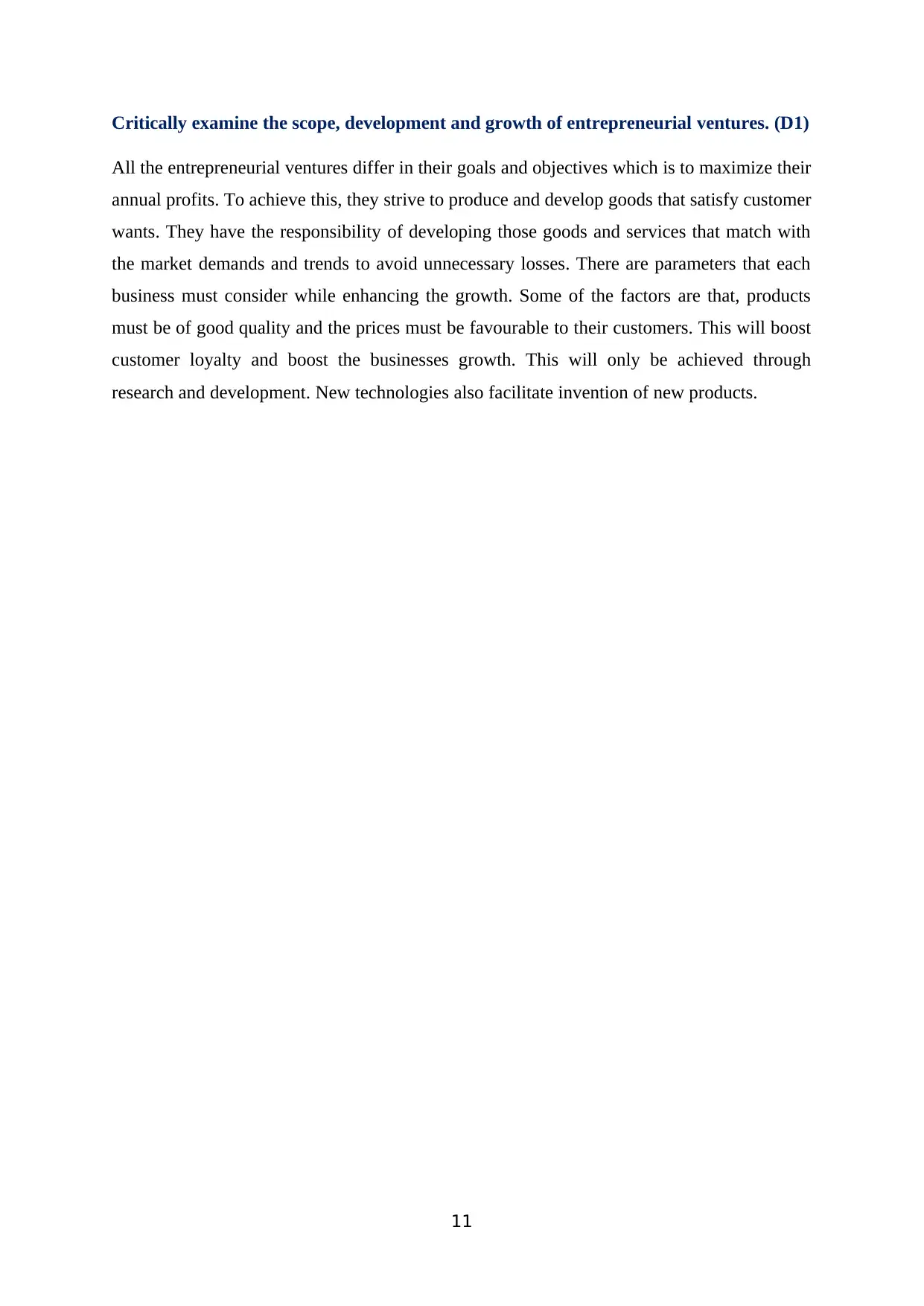
Critically examine the scope, development and growth of entrepreneurial ventures. (D1)
All the entrepreneurial ventures differ in their goals and objectives which is to maximize their
annual profits. To achieve this, they strive to produce and develop goods that satisfy customer
wants. They have the responsibility of developing those goods and services that match with
the market demands and trends to avoid unnecessary losses. There are parameters that each
business must consider while enhancing the growth. Some of the factors are that, products
must be of good quality and the prices must be favourable to their customers. This will boost
customer loyalty and boost the businesses growth. This will only be achieved through
research and development. New technologies also facilitate invention of new products.
11
All the entrepreneurial ventures differ in their goals and objectives which is to maximize their
annual profits. To achieve this, they strive to produce and develop goods that satisfy customer
wants. They have the responsibility of developing those goods and services that match with
the market demands and trends to avoid unnecessary losses. There are parameters that each
business must consider while enhancing the growth. Some of the factors are that, products
must be of good quality and the prices must be favourable to their customers. This will boost
customer loyalty and boost the businesses growth. This will only be achieved through
research and development. New technologies also facilitate invention of new products.
11
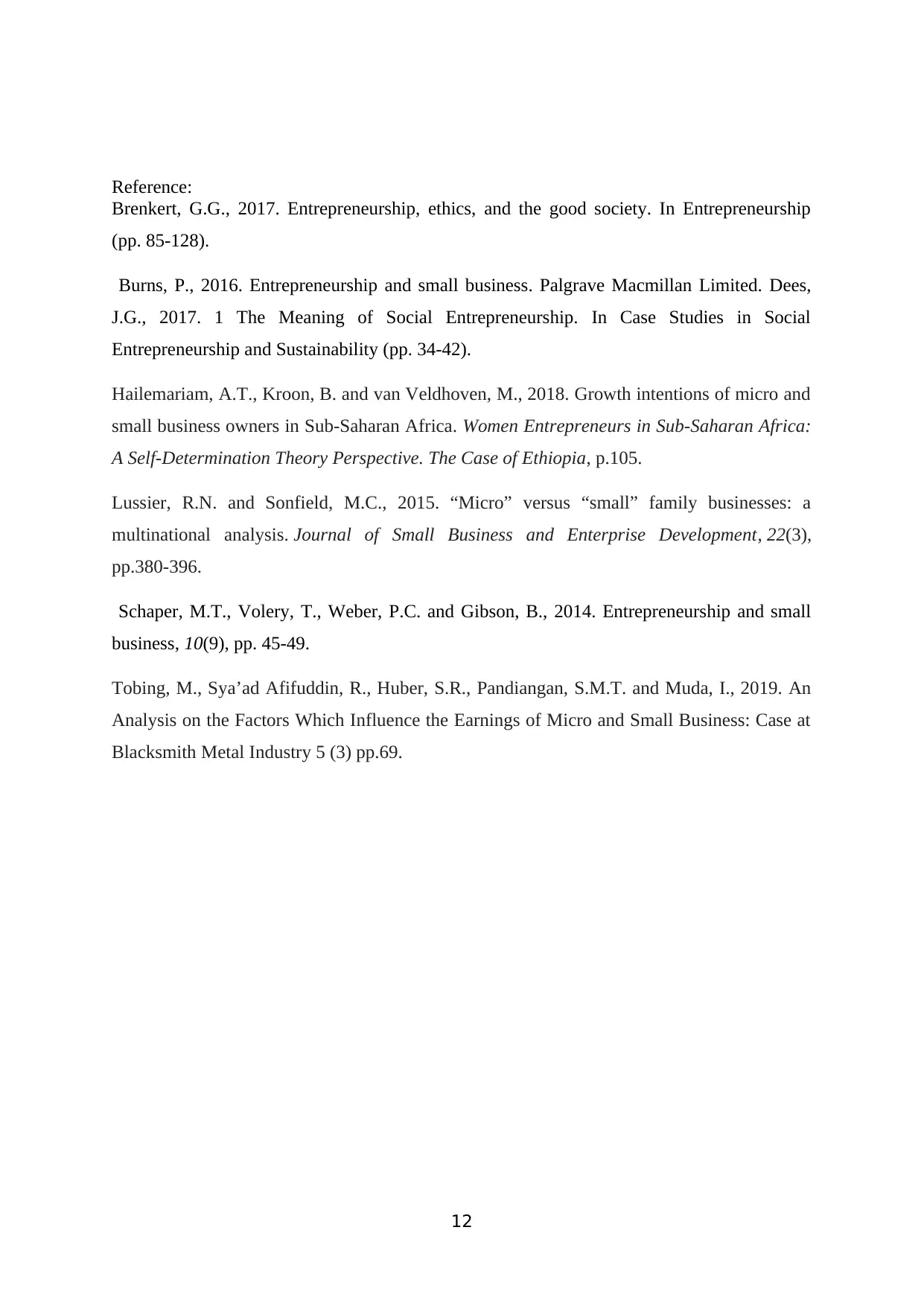
Reference:
Brenkert, G.G., 2017. Entrepreneurship, ethics, and the good society. In Entrepreneurship
(pp. 85-128).
Burns, P., 2016. Entrepreneurship and small business. Palgrave Macmillan Limited. Dees,
J.G., 2017. 1 The Meaning of Social Entrepreneurship. In Case Studies in Social
Entrepreneurship and Sustainability (pp. 34-42).
Hailemariam, A.T., Kroon, B. and van Veldhoven, M., 2018. Growth intentions of micro and
small business owners in Sub-Saharan Africa. Women Entrepreneurs in Sub-Saharan Africa:
A Self-Determination Theory Perspective. The Case of Ethiopia, p.105.
Lussier, R.N. and Sonfield, M.C., 2015. “Micro” versus “small” family businesses: a
multinational analysis. Journal of Small Business and Enterprise Development, 22(3),
pp.380-396.
Schaper, M.T., Volery, T., Weber, P.C. and Gibson, B., 2014. Entrepreneurship and small
business, 10(9), pp. 45-49.
Tobing, M., Sya’ad Afifuddin, R., Huber, S.R., Pandiangan, S.M.T. and Muda, I., 2019. An
Analysis on the Factors Which Influence the Earnings of Micro and Small Business: Case at
Blacksmith Metal Industry 5 (3) pp.69.
12
Brenkert, G.G., 2017. Entrepreneurship, ethics, and the good society. In Entrepreneurship
(pp. 85-128).
Burns, P., 2016. Entrepreneurship and small business. Palgrave Macmillan Limited. Dees,
J.G., 2017. 1 The Meaning of Social Entrepreneurship. In Case Studies in Social
Entrepreneurship and Sustainability (pp. 34-42).
Hailemariam, A.T., Kroon, B. and van Veldhoven, M., 2018. Growth intentions of micro and
small business owners in Sub-Saharan Africa. Women Entrepreneurs in Sub-Saharan Africa:
A Self-Determination Theory Perspective. The Case of Ethiopia, p.105.
Lussier, R.N. and Sonfield, M.C., 2015. “Micro” versus “small” family businesses: a
multinational analysis. Journal of Small Business and Enterprise Development, 22(3),
pp.380-396.
Schaper, M.T., Volery, T., Weber, P.C. and Gibson, B., 2014. Entrepreneurship and small
business, 10(9), pp. 45-49.
Tobing, M., Sya’ad Afifuddin, R., Huber, S.R., Pandiangan, S.M.T. and Muda, I., 2019. An
Analysis on the Factors Which Influence the Earnings of Micro and Small Business: Case at
Blacksmith Metal Industry 5 (3) pp.69.
12
⊘ This is a preview!⊘
Do you want full access?
Subscribe today to unlock all pages.

Trusted by 1+ million students worldwide
1 out of 12
Related Documents
Your All-in-One AI-Powered Toolkit for Academic Success.
+13062052269
info@desklib.com
Available 24*7 on WhatsApp / Email
![[object Object]](/_next/static/media/star-bottom.7253800d.svg)
Unlock your academic potential
Copyright © 2020–2025 A2Z Services. All Rights Reserved. Developed and managed by ZUCOL.




